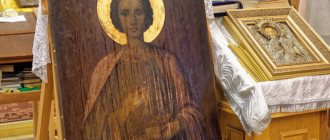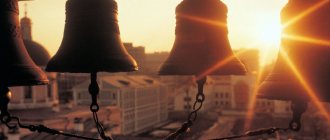What is the purpose of ringing bells in a church?
Photo: Flickr.com
Bells are not rung to attract attention. Each bell ringing contains a specific meaning. The main purposes of the ringing are:
- Notification of the beginning of a church service and invitation of believers to the service.
- At certain moments of the service, ringing emphasizes the solemnity and importance of what is happening in the temple.
- On holidays, ringing expresses the spiritual uplift and joy of believers.
- During the funeral service, the ringing expresses sadness for the deceased, but also joy in the fact that he has moved on to a better life.
All about bell ringing: where to listen
The art of Russian bell ringing has centuries-old traditions. However, time, constantly making its changes throughout life, did not spare the bells. So, for example, instead of the unique, one-piece casting of bells in the 19th century, mass production came; already in the 21st century, “Electronic bell ringers” were increasingly installed on bell towers, and now the bells themselves are “sold” in mp3 recording format. But the ancient craft skills did not disappear without a trace. “St. Petersburg.ru” invites you to remember how it all began, where you can hear the best bell ringing in St. Petersburg, and understand why both believers and atheists stop when they hear the ringing of bells. Metal and spirituality
Bells, like trumpets and drums, came to us from ancient times, where they were an indispensable attribute of pagan cult. So in ancient Rome, a bell in the shape of a flower hung in front of the entrance to the temple of the goddess Cybele.
In Rus', church bells, as a rule, marked the start of the service and had a security function: the alarm announced fires, enemy attacks, and riots. Initially, there were very few bells in Russian churches. In those days, there was only one type of ringing - Blagovest; later, with the addition of more bells, Perezvon appears, which is an enumeration of bells, according to their weight, from larger to smaller and vice versa, as well as Bust and Trezvon. Gradually, with an increase in the bell scale and the weight of the bells, special structures began to be built for them - belfries and, from the 17th century, bell towers, which were located at the temple.
“The Russians loved bells so much that we learned to cast them from foreign masters. Craftsmen came to us with their technologies and their metal. It was a very expensive technology to cast a bell. The method of their manufacture was kept secret for a simple reason - at the same time, it was possible to learn the secret of casting guns. Later, when the “technologies” were mastered, differentiation occurred - different craftsmen cast bells and cannons,” Vladimir Kaychuk, the senior bell ringer at the Cathedral of the Vladimir Icon of the Mother of God, told about the history of the beginning of bell making in Rus'.
In Rus', guns are a symbol of strength. And the bell is a symbol of faith, spirituality, and strength. There was a time when bells were captured, taken captive, given as gifts, and after a won battle a temple or chapel with a bell tower was erected. The next prince tried to cast a larger bell than his predecessor did. There was one more important nuance: the sound of the bell was supposed to “cover” the Russian expanses, since the signaling system then worked precisely thanks to the ringing of the bells. This circumstance contributed to the gradual increase in the size of the bells. But the people of that time, and probably even modern people, could not build a device that could hold huge swinging bells. And the way they sound changed: “ochepny” (when the bell was rocked), was replaced by “tongue” ringing (they rocked the “tongue”).
“Russia is our bell empire and power, and especially Moscow. We have the largest bells in the world,” explains Vladimir Kaychuk.
Renovation or tradition?
The revolution and many years of persecution of the church in Russia led to the almost complete loss of bell-ringing traditions. I would like to immediately note that, due to the specifics of bell ringing, it is difficult to repeat it, but starting from the 19th century, ringings began to be recorded in notes. Thanks in part to this, the next generation was able to reproduce the overall sound pattern.
“We really don’t reproduce the bells exactly as they once were, but fortunately this is not required. In order to understand what kind of bells existed, say, in the pre-revolutionary period of Russian history, you can read numerous testimonies and descriptions reflected both in fiction and in historical documents of that time. A great source of information are also bell works that ended up in classical music, audio and video recordings preserved from the post-war years, and, of course, the traditions of churches and monasteries that did not stop working in Soviet times,” he told the St. Petersburg correspondent .ru" teacher, full-time cleric and bell ringer of the parish of the Nativity of the Prophet John the Baptist in the village of Yukki, head of the St. Petersburg Diocesan School of Bell Ringers, priest Pavel Radin.
In Russia, one of the traditional bearers of bell ringing is the Pskov-Pechersky Monastery; here, during times of church persecution, divine services did not stop, which means that knowledge accumulated over centuries was passed on. The tradition has been preserved in Rostov the Great, and there you can also see ancient bells that survived thanks to the efforts of Anatoly Vasilyevich Lunacharsky, who contributed to the issuance of a safe conduct for them, which made it possible for the unique ensemble of the belfry of Rostov the Great to avoid the fate of the majority of bell towers in revolutionary Russia.
Bell ringer Vladimir Stepanovich Kaychuk said that some traditions of bell ringing were partially recreated. In the 1960s, many researchers tried to restore and understand how Rus' and Russia used to sound, exactly what they sounded like, because all the cities stood in a chain of monasteries, temples, churches, and the ringing of bells was as familiar as the air or the coming spring. The tradition of Rostov the Great, for example, was reconstructed thanks to the filming of a film based on Leo Tolstoy’s novel “War and Peace” in the 1960s. “Director Sergei Bondarchuk, who was shooting the film, needed to reproduce the historical sounding background - bells. At that time, almost no one knew how to call correctly. The cry for Soviet cities brought “old men from Rostov” to Moscow, who as boys heard pre-revolutionary bell ringings, and they helped reconstruct it,” said the senior bell ringer.
There is another way to achieve the former musicality of Russian bell ringing - practice, improvisation and study. Ringers from Veliky Novgorod, Rostov-on-Don, Moscow and other Russian cities are re-birthing the art of bells, gathering at bell music festivals, where they exchange practical experience and study the bell-ringing styles of different regions. But not everything about bell ringing can be learned from a person. As bell-ringer and priest Pavel Radin said, any practicing bell-ringer knows that you learn bell ringing... from your own bell tower. It is the instrument that dictates to the bell-ringer what can be performed on it and what cannot.
Vladimir Kaychuk is confident that almost anyone can become a bell ringer
Improvisation on bells
In addition to church bells ringing, which announce the beginning of services and holidays, thanks to the efforts of virtuosos, such a thing as bell music appeared. Like any other musical instrument, bells are now used for improvisation, with composers and performers composing and "playing" bells outside of its canonical use.
Pavel Radin during the recording of bell ringings
After communicating with different bell ringers, the correspondents of St. Petersburg.ru realized that in bell music there are two types of bell ringers: bell ringers-musicians who perceive their bell towers as an instrument, as a space for creativity and experimentation, and guardians of traditions - they do not strive for individualizing their art, but serving people and God.
“There are no people without a gift. The Lord has endowed all people with his gifts, and each person is individual. And everyone has gifts that others do not have, says Vladimir Kaychuk. — Almost anyone can become a bell ringer, it is important what kind of “stuffing” a person has. Depending on how a person feels, this is how he will call - stiffness, irritation, harmony - everything is visible and audible.”
Ringers can talk about bells like they talk about children. To this day, some people maintain the ancient tradition of giving names to bells. Bells are like people, with their own voice and temperament. Like a child, a bell is “born” special. There is even a science about the study of bells - campanology. Treatment with bell music
“Ringing bells cures any disease, and bells destroy all harmful viruses, bacteria and microbes,” such information regularly appears on the Internet, and among its supporters there are many near-medical people. However, according to Father Pavel, such speculation has no basis. But there is a “physical” explanation why a person, anyone, is at least interested in listening to bell music.
“The whole point,” explains Father Pavel, “is that the “composition” of bell music is unique. The main feature of the sound of a bell is that when the “tongue” of the bell hits its edge, not one, but several sounds—overtones—appear at once. They are arranged in a strict order and are practically indistinguishable by ear, merging for us into a single note. However, the sound spectrum of a bell is a special combination of overtones, the ratio of which is individual for each of them. and whether we like it or not, the brain begins to try to solve this riddle, understand the picture, recognize the sound. He tries to arrange the overtones he hears in the sequence in which he learned to hear them and in the order that is convenient for him and seems logical. He searches and does not find, because the peculiarity of the sound spectrum of a bell is its inharmonious structure and, for this reason, the partial tones that our brain needs to obtain a full picture of the sound may simply not exist.” This work of the brain gives sensitive people a feeling of increased health.
Carillon of the bell tower of the Peter and Paul Cathedral
Vladimir Kaychuk
Pavel Radin
Bell towers you can't pass by
On the advice of the bell ringer of the Cathedral of the Vladimir Icon of the Mother of God Vladimir Kaychuk and the teacher, full-time cleric and bell ringer of the parish of the Nativity of the Prophet John the Baptist in the village of Yukki, the head of the St. Petersburg Diocesan school of bell ringers, priest Pavel Radin, we have compiled a list of bell towers where you can hear the best St. Petersburg bell ringings:
1. Peter and Paul Cathedral (Cathedral in the name of the supreme apostles Peter and Paul) Orthodox cathedral in St. Petersburg in the Peter and Paul Fortress, the tomb of the Russian emperors. The bell tower is still the tallest bell tower of the Russian Orthodox Church. Its height is 122.5 meters: a 40-meter gilded spire, a 60-meter stone structure and some superstructures. The bell ringing of the Peter and Paul Cathedral includes one of the heaviest surviving historical bells in St. Petersburg - the 5-ton blagovestnik. There is also a carillon on the bell tower. Peter and Paul Fortress, Hare Island
iskusstvu.ru
2. Holy Trinity Cathedral of the Alexander Nevsky Lavra is the cathedral church of the Alexander Nevsky Lavra in St. Petersburg. Construction of the cathedral began under Emperor Peter I. The cathedral was consecrated on August 30, 1790, at which time the relics of St. book Alexander Nevsky, in addition, a particle of the relics of St. Apostle Andrew the First-Called is buried in the cathedral. Embankment of the Monastyrka River, building 1
clubs.ya.ru
3. Spaso-Preobrazhensky Cathedral (Cathedral of the Transfiguration of the Lord of All Guards) is an Orthodox church of the St. Petersburg and Ladoga diocese of the Russian Orthodox Church. Built according to the design of V.P. Stasov in 1829 on the site of an earlier temple. A monument of classicism architecture. Never closed for worship; in the 1920s - 1940s, in certain periods it was under the jurisdiction of various “renovationist” structures. The names of Preobrazhenskaya Square (formerly Radishchev Square), on which it stands, and the nearby Radishchev Lane (formerly Tserkovny Lane) come from the Transfiguration Cathedral. Preobrazhenskaya Square, building 1
spbfoto.spb.ru
4. The Cathedral of the Vladimir Icon of the Mother of God is an active Orthodox church on Vladimir Square in St. Petersburg. Dedicated to the Vladimir Icon of the Mother of God, one of the most revered icons in Rus'. The names Vladimirsky Prospekt and Vladimirskaya Square come from the Vladimir Church. Bell ringings can be heard every day: 20 minutes before the start of morning and evening services. Saturday evening (from 18:00), Sunday (from 10:00), and on holidays. Vladimirsky prospect, 20
al-spbphoto.narod.ru
5. Church of the Savior Not Made by Hands, the building was originally built for other purposes. In 1736, in connection with the desire of the employees of the court stable yard to have their own temple, Empress Anna Ioannovna ordered the creation of a church here. It was then that the wooden Church of the Savior Not Made by Hands was built in the chamber above the gate, and later a stone one. In 1837, the funeral service for Alexander Sergeevich Pushkin was held in the church. After 1917, the temple was looted, in 1919 it was closed, the temple library was destroyed, and the bells were melted down. In 1923, the Mounted Police Club was opened here. The stable church was returned to believers in 1991. By 1999, restoration was carried out. Currently, every February 1st, a memorial service for A.S. Pushkin is held here. Konyushennaya Square, 1
ipetersburg.ru
6. Church of the Smolensk Icon of the Mother of God (Smolensk Church) is one of the oldest Orthodox churches in St. Petersburg. Located at the Smolensk cemetery. According to legend, St. took part in the construction of the church. Blessed Ksenia of Petersburg, who secretly carried bricks to scaffolding at night. Vasilievsky Island, Kamskaya St., 24
kuraev.ru
7. Cathedral of the Holy Apostle Andrew the First-Called (St. Andrew's Cathedral) is an active Orthodox cathedral on Vasilievsky Island in St. Petersburg, an architectural monument of the 18th century. In 1729, a new church in the name of the Holy Apostle Andrew the First-Called was founded on Vasilievsky Island, and in 1732, consecrated. In 1744, the church was given the status of a cathedral. Vasilyevsky Island, 6 line, building 11
fotki.yandex.ru
8. Temple of the Fedorov Icon of the Mother of God in honor of the 300th anniversary of the House of Romanov The temple is made in the style of the Rostov cathedral churches of the era of the accession of Mikhail Fedorovich. In 1907, to commemorate the approaching 300th anniversary of the House of Romanov, it was decided to build a cathedral in the capital. The foundation stone of the temple took place on August 5, 1911 in the presence of Grand Duke Mikhail Alexandrovich. The parish operated until 1932. The temple-monument was turned into a dairy factory and rebuilt, its domes were demolished. For 40 years, the church, completely redesigned inside, stood decapitated. In 1993, the city authorities transferred the Feodorovsky Church to the diocese. On March 27, 2011, the restoration of the bell tower was completed, onto which an exact copy of the 19th century bell ensemble was erected. You can hear the bells ringing 20 minutes before the start of the service. Mirgorodskaya street, 1
feosobor.ru
9. Church of the Nativity of John the Baptist in the village of Yukki is an Orthodox church, construction of which began in April 2009. As the church bell ringer Father Pavel said, despite the fact that all the bells are modern from factories in Moscow, Voronezh, Yaroslavl, the concept of authentic bells has been preserved there. Bells have always been collected over decades, and this situation can be imitated by collecting bells from different manufacturers. Currently, the Temple in Yucca is still being completed, but you can already hear the bell ringing. You can hear the bells ringing 20 minutes before the start of the service. Usually daily at 9:40 and 16:40.
fotki.yandex.ru
10. Church of the Annunciation of the Blessed Virgin Mary is an active Orthodox church. In 1994, the parish of the Annunciation Piskarevskaya Church was founded in the Bolsheokhtinsky deanery. The parish, which united people with disabilities of the musculoskeletal system and people helping them, conceived and began to implement the creation of a church complex on Piskarevsky Avenue in St. Petersburg. Currently, services are regularly held in the church, a Sunday school for children and adults operates, and a library of spiritual literature is open. Piskarevsky prospect, house 41
fotki.yandex.ru
11. Church of the Resurrection of Christ near the Warsaw Station (Church of the Resurrection of Christ of the All-Russian Alexander Nevsky Brotherhood of Temperance) is an active church in St. Petersburg, part of the Admiralty Deanery District. At the end of the 19th century, the area near the Warsaw and Baltic railway stations was the working outskirts of the capital. The St. Petersburg Society for Religious and Moral Education in the spirit of the Orthodox Church petitioned the city authorities to allocate a plot of land for the construction of a temple. The first wooden Church of the Resurrection of Christ was built in 1894. Obvodny Canal Embankment, building 116
al-spbphoto.narod.ru
12. Church of the Presentation of the Lord is an Orthodox church in St. Petersburg on the banks of the Murinsky stream at the corner of Grazhdansky Avenue and Lunacharsky Avenue. Rings for weekday services are made with one bell. All bells can be rung on any Sunday or all Twelfth Holidays from 9:45 to 10:00 and after the service (approximately around 12:00 for 10 minutes). Civil Avenue, building 101
al-spbphoto.narod.ru
13. Church of the Holy Apostle Peter in Vesyoly Poselok, the parish was registered only in 2005. The temple was designed in the New Russian style with complex multi-vaulted architecture. Iskrovsky Avenue, 11
al-spbphoto.narod.ru
Text: Marina Belyaeva Photo: Yuri Strofilov
History of bell ringing
Photo: Flickr.com
Since ancient times, in order to call people to the temple for prayer, they used some objects capable of producing a strong sound that could be heard in all parts of the village. At first it was one signal bell. But then the art of bell ringing developed, and larger and smaller bells appeared, producing sounds of different strength and pitch. Bells were cast from different metals and alloys, which were harmoniously connected in resonance with each other.
The purpose of bell ringing in those days was to gather people for prayer, since it should be conciliar and universal. People should praise the Lord together in the temple of God.
Legends and research of bell ringing
Long-term studies of bell ringing have proven that positive energy is generated in the space of the bell. According to legends, ringing bells saved people from epidemics and negative energy.
In its strength, power and beauty, it is healing for humans, it is able to heal the soul and body, restores energy, strengthens physical health and harmonizes the psyche.
When the bell rings, the space is saturated with positive energy, filling the air with the energy of love and goodness. The sound wave travels in the form of a cross. Bells are energy generators in the ultrasonic range; it is used to sterilize space.
Only live sound has this effect. It is known that bell ringers do not suffer from colds. An audio recording of bell ringing can be listened to at home, where quarrels and conflicts are frequent, it cleanses the space of negative energy.
What type of bell ringing is there?
Ringing in Russia is different from other countries. In Rus', since ancient times, belfries were arranged in such a way that the sound was not produced while the bell was swinging along with the tongue. Our bells were struck - that is, the bell was motionless, and the tongue struck it, swinging like a pendulum on a rope.
Of course, this method provided much more opportunities to express one’s feelings in the ringing of bells; the sound was more subtle, predictable and melodic. Also, as already mentioned, the variety of sizes and shapes of bells made it possible to fully comply with the canons and produce not only temple bells, but also melodies.
Ringing bells restores a person's aura
Bell ringing can restore a person’s energy field. During observations, an increase in the symmetry and area of the human energy field was recorded. Thus, it was revealed that a person’s energy was restored after listening to the ringing of a bell.
In addition, the ringing of bells enhances the vibration of the surrounding space and people. Negative energy with low vibration is dissolved, it is crushed and leaves the human biofield.
The ringing of bells is able to resonate with the human energy system, thereby activating the chakras and increasing a person’s energy potential. Today there is no longer any doubt about the beneficial effects of bell ringing on human health:
- it relieves a person from stress,
- contributes to the normalization of metabolism and the activity of the cardiovascular system,
- restores autonomic dysfunctions, which are accompanied by fears, depression and sleep disturbances.
Types of bell ringing and their meaning
Photo: Flickr.com
Each ringing of the bells makes it clear what event is being celebrated on the church calendar and what is currently happening in the church during the service.
Blagovest
These words denote separate, solo strikes on a large bell. They are published at the beginning of the service, during the Eucharist at the liturgy. If another service is being served, the bell sign marks the beginning of the reading of the Gospel. Blagovest can be not only single, but also included in other types of ringing. The more important the church holiday, the longer and louder the Blagovest.
Trezvon
To express joy and celebration, several different bells are rung at the same time. It can be heard after the gospel or before the start of important holiday services. All the bells ring - large (they are called blagovest), medium (they are called bells) and small (zazvonny).
Chime
It is issued by striking each bell in turn, starting with the largest one and ending with the smallest one. This is a solemn type of ringing. It is used only on certain days of the Holy Week of Great Lent and during the blessing of water for Epiphany.
Bust
Also alternate strikes on each bell, but starting from small to large. And then all the bells are struck at once. This is a funeral bell and is emitted during the funeral service for the deceased.
Types of ringing - bell, chime, ringing, trezvon
There is no complete classification of all bells in science yet. There are many discrepancies in the bells because... ringing is an oral tradition and local traditions are important.
A few examples of good news:
Single strikes whose characteristic features are evenness, regularity, and persistence.
Single blows turning into trezvon (not pure blagovest) Cathedral of the Epiphany in Yelokhov
Frequent blagovest (ringing bells on both ends + ringing bells - a single complex) Blagovest
The bell, called the bell, is intended to announce the upcoming start of the service. The Blagovest “... not only notifies about the time of the beginning of the service, but also prepares Christians for it... It, in fact, is already a Divine service” -
says Professor Mikhail Skaballanovich in the “Explanatory Typikon”. The gospel is carried out, as mentioned above:
on great holidays -
in the holiday bell
before Sunday services -
in the Sunday bell.
The bell ringer, as follows from the instructions of the Typikon, before ringing, is supposed to take a blessing for the ringing from the primate (the priest who is to perform the service). “Before the sun sets on the Sabbath day, the paraecclesiarch (that is, the candilo-burner) comes to the primate and worships him, signaling with his arrival the time of riveting...”
(“Typicon”, chapter 1).
The blessing of the priest determines the blagovest, as well as other ringing, the status of a liturgical action.
The position of bell-ringer, as we see from the instructions, is performed by the paraecclesiarch - in the modern version - a sexton, altar boy or reader. However, in our time, those who have been blessed by the rector have the right to make calls, regardless of whether this person belongs to the ranks of clerics, clerics, or is simply a parishioner.
It is recommended that the bell ringer read the blameless (17th kathisma) or the 50th psalm 12 times during the gospel service. “The same ascending strikes the great com-pan not soon, singing the blameless, or saying Psalm 50 to 12”
(“Typicon”, chapter 2). From this indication it follows that the duration of the ringing corresponds to approximately 20 minutes. However, now this time has decreased (due to the fact that the ringing now carries a more symbolic than practical meaning) and is approximately 10 minutes; at the beginning of the gospel, two strikes are made on the designated bell until the sound completely fades, and from the third, measured strikes begin . The interval between strikes should be chosen so that it corresponds to the voice of the bell, otherwise the ringing may turn out mournful (if the strikes are too rare), or alarming (in the case of very frequent strikes).
complex).
Chime - ascending sequential slow from the largest low bell to the smallest high
Bust – descending sequential slow from the smallest bell to the largest
Bust
Overkill is a death knell and, despite its simplicity, also has variations. When burying priests, hieromonks, abbots, and archimandrites, before rehearsing, the largest bell is struck 12 times, then each bell is struck 1 time from small to large, symbolizing human life in its development and maturation.
When burying “worldly people,” first, all the bells are run through from small to large (as in the first case, but without 12 strikes), and at the end of the sweep, all bells are struck once at the same time, symbolizing the interruption of earthly life.
Trezvon is the ringing of two or more bells. It is necessary to remember the main division - holiday and guard duty
Trezvon
This ringing can be done in one step, in two or in three (depending on what service of the daily circle it is intended for). The daily cycle of services contains three main services - Vespers, Matins and Liturgy. That's why:
before Vespers
the ringing is performed in
one
step;
before Matins,
since this is the second service, the trezvon is rung
in two
steps;
before the Liturgy - at three.
In addition, there are varieties of trezvon called “Red Ring”
and
“Ring in two.”
The following can be said about the “Red” ringing: in the “Typikon” there is an expression: “ringing in the red”
(“Typikon”, chapter 49; On Wednesday, 5th week) -
In this case, the use of medium bells, not large ones, is indicated, since the Lent period has not yet ended.
In the old days, middle bells were called “red” because of their pleasant voice. The word “red” in Church Slavonic means “beautiful, pretty, beautiful.” For example, when singing Psalm 136 “On the Rivers of Babylon...” in the “Typikon” in preparation for Great Lent on Sunday all-night vigils, it is stated: “We sing with red hallelujah.”
It seems that it would not be a gross mistake to consider that “red” is a trezvon that is distinguished by its beauty and variety of rhythmic figures, creating a feeling of pure triumph and jubilation.
“In general, one should call for Vespers, Matins and Liturgies without any excess” -
indicated in the “Training Charter” with reference to the definition of the Holy Synod.
Ringing “in two” is performed before Little Vespers, the Liturgy of the Presanctified Gifts, on Holy Wednesday after Matins, and other cases when it is desirable to use trezvon, but the rules do not allow ringing in a festive manner.
They ring “in two” by striking the hourly clock and the next largest bell in turn.
Consecutive ringing of the bells is used in liturgical practice to emphasize the importance of the upcoming service or action.
Melism is a melodic decoration of sound that does not change the tempo and rhythmic pattern of the melody
Simple trill - playing in sixteenth notes
Quick trill - thirty-second birthday
Grace note - melisma, consisting of one or more sounds preceding the main sound, performed due to its duration
Short farshlag - performed by bells of one group
Long grace note - performed using auxiliary bells from other groups
Ticket#6
Types of ringing
There are a large number of calls:
Everyday - simple trezvon, using an everyday evangelist without any special decorations
Festive - as a rule, a long, beautiful ringing with the possibility of using all evangelists
Easter - a special holiday peal
Red – from Easter to Thomas Week
Counter pealing - most often used when meeting the bishop (15 minutes before the bell rings, when a car appears - a festive peal (when the bishop meets the bishop in front of the church by the rector - the ringing stops when the bishop enters the temple again, the festive peal rings for 3-4 minutes)
Raspberry ringing - 1 In Belgium there is a city of Mechelen (in another transcription - Malin), famous for its beautiful ringing sounds. 2.Korolenko – “The Blind Musician”: crimson color – softened red. And the ringing is just as soft, not new bells, having an emotional connotation similar to the color crimson.
Water Blessing - chime + trezvon for the blessing of water. (Chime of 7 beats with interruption starting from the 4th blow). In different charters, the number of strokes when ringing back varies (it is recommended to follow local traditions). When the cross is immersed, a festive peal is rung.
Polyeleos - during services with polyeleos, using a polyeleos evangelist.
To move the icon - three blows - they set off and are greeted with a chime (Novosibirsk version)
Alarm bells were rung during a fire, during an attack by enemies, and during other disasters. It is an alarming frequent ringing of one not very large bell. Tsar Alexei Mikhailovich issued a decree for Moscow on alarm bells. This decree prescribed how the location of a fire could be determined by the method of ringing - they identified areas and sections of streets where there was a fire.
Vechevoy - for a meeting of all the people at a veche - Novgord, Pskov, Moscow.
Blizzard - intermittent ringing in bad weather of one not very large bell, as a guide for lost travelers
Ringing for the funeral service: burial of the laity - moving from a small bell to a large one, followed by a full blow. When the procession leaves the temple, a peal is rung (not fast, solemn). In the Minsk charter, the burial of priests, hieromonks, archimandrites and bishops - when going to the temple, they first strike the festive bell 12 times, then go from small to large bells with a full blow and again 12 bells, etc. until the deceased is brought into the temple. When brought into the temple, a peal is rung. After reading the prayer of permission, the ringing of the bell rings. When taking the deceased out of the temple: 12 good news, enumeration, etc. and when placing him in the grave (or car) - a ringing bell
In the charter of N. Zavyalov - Bust
Overkill is a death knell and, despite its simplicity, also has variations. When burying priests, hieromonks, abbots, and archimandrites, before rehearsing, the largest bell is struck 12 times, then each bell is struck 1 time from small to large, symbolizing human life in its development and maturation.
When burying “worldly people,” first, all the bells are run through from small to large (as in the first case, but without 12 strikes), and at the end of the sweep, all bells are struck once at the same time, symbolizing the interruption of earthly life.
Ticket No. 7
Bells of Great Lent - on weekdays of Great Lent the gospel is performed (the first 3 strikes until it subsides, then 40 strikes). On the clock:
3 hours - 3 blows at intervals of 10 -15 seconds at the guard bell
6 hours – 6 beats
9 o'clock - 9 beats
On visual ones there is no ringing
Before Compline - 12 strokes (from Monday to Thursday of the 1st week at Compline the Great Canon of St. Andrew of Crete is read. On these days for Compline it is prescribed: “The candle-burner enters and, having bowed to the primate, he strikes the beater 12, and we all gather in the church.” Currently, the gospel is being celebrated on the Lenten bell.
On Wednesday and Friday throughout the entire period of Lent, the Liturgy of the Presanctified Gifts is served. The most asked question: “At what point do they ring the double before the Liturgy of the Presanctified Gifts?” We answer: “Before the beginning of Vespers, according to the Typikon”
Double ringing - ringing two bells - a sentry bell and a smaller one, next from it, followed by a strike on both bells. (from the ringing calendar of I. Drozdikhin) Or ringing two bells - a sentry bell and a smaller one, alternately (N. Zavyalov), there are other options , but we recommend the ringing used in the charter of N. Zavyalov
During the period of fasting, services with polyeleos are not performed, except on February 24 (the finding of the head of John the Baptist) and March 9 (the day of the 40 Martyrs of Sebaste). These days the polyeleos ringing is supposed. For this reason, the hourly ringings are canceled: “Whenever we eat polyeleos, we do not strike the company during the hour.”
During Lent, the nature of Sunday bells should not be changed. Sunday is Little Easter.
On Saturdays and Sundays, fasting for the service is postponed, and the full liturgy is celebrated. Consequently, already on Friday, no great bows are required for Great Compline, and accordingly, non-fast bells are assigned for the evening services.
At vespers on Sundays, the good news is rung with a large bell, since the fast itself begins after vespers, and also because at these vespers the entrance is made and the great prokeimenon is proclaimed.
In the 3rd week, the Worship of the Cross, in the rite of carrying out the cross, the chime of 3 strikes is performed on each bell (at the Great Doxology), and at the moment of the procession with the cross to the middle of the temple, the ringing of the bell is performed “in full”, which continues until the cross is laid on the lectern.
There is no indication of this in the typikon, but in the statutes of the Moscow Assumption and Novgorod Sophia Cathedrals that have come down to us, this ringing is present. Currently, this ringing has already become part of the rite of the all-night vigil and has become traditional. The author believes that this was borrowed from the celebration of the Exaltation of the Cross.
Where you can listen to the healing ringing of church bells
For healing, it is best to go to places of worship, such as monasteries. One of the most revered holy places is Optina Pustyn.
In Optina Hermitage there is a unique wooden belfry. Despite the fact that the belfry was desecrated by the murder of monks, pilgrims come here constantly in the hope of healing.
The Trinity-Sergius Lavra has the highest bell tower in Russia - 90 meters.
Fans of bell ringing and those simply wishing to experience its healing power can visit a number of themed festivals. “Ufalian Blagovest” will take place in Upper Ufaley, the All-Russian Bell Ringing Festival is held annually in Yelabuga, and “Crystal Bells” can be heard in Kargopol.
People believe in the special properties of bell ringing and turn to it for support, healing and purification, and see it as the personification of hope. The phenomenon of bell ringing is amazing and fascinating.










